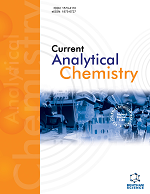- Home
- A-Z Publications
- Current Analytical Chemistry
- Previous Issues
- Volume 18, Issue 10, 2022
Current Analytical Chemistry - Volume 18, Issue 10, 2022
Volume 18, Issue 10, 2022
-
-
Methods for Measurements of Oxidized LDL, Homocysteine and Nitric Oxide as Clinical Parameters of Oxidative Stress and Endothelial Dysfunction
More LessAuthors: Mirjana T. Macvanin, Julijana Stanimirovic and Esma R. IsenovicTimely and accurate evaluation of clinical parameters associated with endothelial dysfunction is critical in diagnosing and treating atherosclerosis, which represents a severe health problem, accounting for at least 30% of deaths globally. A critical early event in the pathogenesis of atherosclerosis is the oxidative modification of low-density lipoprotein (LDL). Oxidized LDL (OxLDL) represents numerous changes in lipid Read More
-
-
-
Technical Advances in the Chiral Separation of Anti-diabetic Drugs Using Analytical and Bio-analytical Methods: A Comprehensive Review
More LessChirality seems to be a pivotal technique in the field of science. Research teams are quite well versed in empirical separation, however, at the same time, they are clueless about the evolution of chiral separation. As per the guidelines of the United States Food and Drug Administration (US FDA), chiral drugs must be unraveled before they are sold to the public. Stereogenic separation has gained prominence during the last 10 dec Read More
-
-
-
Removal of Cd (II) Ions from Water Solutions Using Dispersive Solid-Phase Extraction Method with 2-aminopyridine/graphene Oxide Nano-Plates
More LessAuthors: Milad Abniki and Ali MoghimiBackground: The effluent release containing heavy metals, such as Cd (II) ions, poses drastic risks to both the natural environment and human health. In this research, a novel nano sorbent from the pyridine derivative was prepared for dispersive solid-phase extraction of Cd (II) ions. Methods: Graphene oxide (GrO) was chemically modified by a 2-aminopyridine group (2Ap) through a multistep procedure. The effect of Read More
-
-
-
Assay of Trace Copper Ion in Water Resources Using a Photo-sensing Diode Circuit
More LessAuthors: In H. Cho, Kwang Jin Choi, Jong Wan Choi, Kyung Lee, Suw Young Ly, Ah Young Kwak and Lee Joo YoubBackground: In this study, trace copper plays an important role in plant growth and is a biological component of various enzymes involved in both photosynthesis and plant respiration. Objective: Electrochemical voltammetric bioassay of trace copper ion was detected using photo-sensing diode circuits (PSD) with working sensors for ppb levels trace detection in agricultural water by stripping and cyclic voltammetry. Results: Opti Read More
-
-
-
Elemicin-rich Cymbopogon khasianus (Hack) Stapf (ex Bor) Essential Oil: Pharmacological Effects, Toxicological Investigation, and Compositional Analysis
More LessBackground: Cymbopogon khasianus is a widely used industrial and pharmacologically important aromatic grass species. Objective: The present investigation was designed to study and compare the elemicin rich Cymbopogon khasianus essential oil (EREO), its pharmacological effects and genotoxicity with pure compound elemicin. Materials and Methods: Chemical composition identification was performed using GC/MS and Read More
-
-
-
Novel Gatifloxacin3-Carboxamide Derivatives as Anti-Tumor Agents: Synthesis, Enantioseparation, and Molecular Docking
More LessAuthors: Fatima. Z. Mimouni, Nasser Belboukhari, Khaled Sekkoum and Hassan Y. Aboul-EneinBackground: The affinity of a drug to the identified target (protein/enzyme) is a critical characteristic in the development of a novel drug. Fluoroquinolone derivatives with a carboxylic group change have improved antimicrobial and anticancer activity while maintaining antibacterial activity similar to parent drugs. Aim: In this paper, the rationale upon which synthesis of the new compounds is based, evaluation of thei Read More
-
-
-
Hot Stage Microscopy-based Method for Determination of Particle Size in Reverse Engineering: Establishment of a Platform Technology Employing Carvedilol as a Model Drug
More LessAuthors: Jayshri Deore, Niraj Rajput, Tarang Jadav, Amit K. Sahu and Pinaki SenguptaAim: To develop a hot stage microscopy-based method for the determination of particle size in reverse engineering and establishment of a platform technology employing carvedilol as a model drug. It was hypothesized that reverse engineering using thermal methods would suggest a logical path in decoding the innovator’s formulation to develop an efficient generic product and preconize the morphology of an active pharmaceuti Read More
-
-
-
Effect of Suspended Solids and Organic Matter in Water on the Removal of ZnO-NPs by Coagulation
More LessAuthors: Jiaqing Tao, Changrong Zhao, Chang Zhuang, Zhaoyang You and Kinjal J. ShahBackground: Zinc oxide nanoparticles (ZnO-NPs) have been shown to exert a non-negligible impact on the environment. Objective: Kaolin and humic acid were used in the aqueous environment to study their effects on the removal of ZnO-NPs. Methods: In this work, polyaluminum ferric chloride (PAFC)/cationic polyacrylamide (CPAM) coagulants were used together with kaolin and humic acid to study their effects on the r Read More
-
Volumes & issues
-
Volume 21 (2025)
-
Volume 20 (2024)
-
Volume 19 (2023)
-
Volume 18 (2022)
-
Volume 17 (2021)
-
Volume 16 (2020)
-
Volume 15 (2019)
-
Volume 14 (2018)
-
Volume 13 (2017)
-
Volume 12 (2016)
-
Volume 11 (2015)
-
Volume 10 (2014)
-
Volume 9 (2013)
-
Volume 8 (2012)
-
Volume 7 (2011)
-
Volume 6 (2010)
-
Volume 5 (2009)
-
Volume 4 (2008)
-
Volume 3 (2007)
-
Volume 2 (2006)
-
Volume 1 (2005)
Most Read This Month
Article
content/journals/cac
Journal
10
5
false
en


